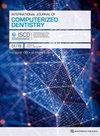Aim: The aim of the present study was to evaluate the segmentation accuracy of the dentition by testing four open-source semi-automatic software programs.
Materials and methods: Twenty CBCT scans were selected to perform semi-automatic segmentation of the maxillary and mandibular dentition. The software programs tested were InVesalius, ITK-SNAP, 3D Slicer, and Seg3D. In addition, each tooth model was manually segmented using Mimics software; this was set as the gold standard (GS) reference of the investigation. A specific 3D imaging technology was used to perform the superimposition between the tooth models obtained with the semi-automatic software and the GS model as well as to perform the surface-to-surface matching analysis. The accuracy of semi-automatic segmentation was evaluated, calculating the volumetric mean differences (mean bias and limits of agreement) and the percentage of matching of the tooth models compared with the manual segmentation (GS). Qualitative assessments were performed using color-coded maps. All data were statistically analyzed to perform comparisons between the investigated software programs.
Results: Statistically significant differences were found in the volumetric and matching percentage data (P 0.05). InVesalius was the most accurate software program for 3D rendering of the dentition, with a volumetric bias (Mimics software) ranging from 4.59 to 85.79 mm3, while ITK-SNAP showed the highest volumetric bias, ranging from 30.22 to 319.83 mm3. The mismatched area was mainly located at the radicular tooth region. The volumetric data showed excellent inter-software reliability, with coefficient values ranging from 0.951 to 0.997.
Conclusion: Different semi-automatic software algorithms could generate different patterns of inaccuracy error in the segmentation of teeth.


